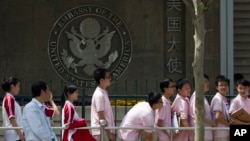Student Union
Sushi Served With a Secret Ingredient: Microplastic

The beautiful, all-you-can-eat sushi platter you shared with friends last week might have included a special ingredient: plastic.
Microplastics — the remnants of plastic bags, takeout containers and straws that almost-but-not-quite disintegrate in the oceans — are found in 3 out of 4 fish, such as squid, cuttlefish and swordfish in markets around the world, say the authors of a February study.
“These fish inhabit a remote area, so theoretically they should be pretty isolated from human influences, such as microplastics,” said Alina Wieczorek, lead author of the Frontiers study.
“However, as they regularly migrate to the surface, we thought that they may ingest microplastics there,” she said.
Food chain pollutants
Consumers are waking up to pollutants in their food chain, and scientists are joining them to raise awareness and combat other issues like overfishing. Last week, thousands marched in the United States and 25 other countries for World Oceans Day.
Under the hood of a shark costume was Brian Yurasits, director of development at the nonprofit TerraMar Project, which educates and promotes ocean issues. Yurasits circulated with about 3,000 others at the march in the shadow of the Washington Monument and a life-size, inflatable blue whale.
Holding a sign that read, “Sharks are friends, not food,” Yurasits emphasized that issues about ocean health “is more than just plastic.”
[See our video interview with Yurasits here.]
“It’s overfishing, climate change, invasive species and habitat loss,” he said.
The youth-led Sea Youth Rise Up advocates for ocean conservation, including reduced single-use plastics such as plastic straws, water bottles and shopping bags, which the ocean breaks down into microplastics. Much of the plastic that ends up in the oceans was blown into rivers first from uncontained trash on land.
Microplastics are microscopic and smaller than plankton, a popular food choice of larger marine life. They are made of hydrocarbons, a compound found in petroleum and natural gas, and attract other pollutants, according to the National Association of Geoscience Teachers.
Because microplastics can’t be digested, they build up in the fish that consume them.
“The biggest impacts aren’t the ones we can see very easily,” said Katie Farnsworth, a professor and marine geologist who studies coastal sediments at the Indiana University of Pennsylvania. “The biggest danger is those microplastics, because they are being eaten by things in the bottom of the food web, and then move their way up through the chain.”
The plastics can give off toxins, she said, because plastic is made from hydrocarbons. And hydrocarbons, she explained, attract and bind with other pollutants that are in the ocean.
Carbon dioxide
But microplastics aren’t the only threat to marine life. Ocean acidification and overfishing also imperil the health of oceans.
Ocean acidification occurs when seawater absorbs carbon dioxide from the atmosphere. Carbon dioxide is released into the air by burning fossil fuels, like oil and coal. That makes the ocean more acidic, which harms shellfish, other marine life and plants.
Ocean acidity has increased about 25 percent since the Industrial Revolution starting in 1760, the EPA reports, commonly depicted by billowing smokestacks at coal-burning factories.
Julia Dohner is a second-year Ph.D. student studying marine chemistry and geochemistry at the Scripps Institution of Oceanography in San Diego. She is also a surfer who spends lots of time in the Pacific Ocean.
“Everything I think about is through the context of carbon dioxide,” Dohner said. “For me, reducing one’s carbon footprint is really important. It’s kind of a straightforward task, if you want to do something about the environment.”
Dohner said she believes awareness of ocean acidification has increased in the past few years.
“There’s been a lot of effort going into understanding how quickly our oceans are acidifying and understanding how those conditions will affect various forms in the ocean,” Dohner said.
Overfishing
Overfishing also threatens ocean health. It occurs when more fish are caught than the population can replace through natural reproduction. According to the World Wildlife Federation, several important commercial fish populations, such as Atlantic bluefin tuna, have declined to the point where their survival as a species is threatened.
Regulating overfishing is nearly impossible because “fish could care less about political boundaries,” said Farnsworth, meaning fishing boats follow the fish, often disregarding lines drawn around territorial boundaries.
“Regulations in one country don’t help very much because you have to get treaties to get everybody in agreement,” she said.
Dohner said she believes that the biggest threat the ocean faces is a lack of awareness of these issues.
“There’s all this research going on about how our planet is changing and what it’s going to look like in the future,” Dohner said. “But at the end of the day, if we can’t convince people such that there is tangible policy changes enacted, then what have we really accomplished?”
Join the Student Union conversation on our Facebook, Instagram, Twitter and LinkedIn social media pages.
See all News Updates of the Day
- By VOA News
International students discuss US campus culture shock

International students at De Anza College in Cupertino, California, talked about culture shock in an article in La Voz News, the student newspaper.
"It felt like a major culture shock. Everything was so different, from academics to mannerism," said a student from Mexico.
Read the full story here.
These are the most expensive schools in the US

High tuition costs along with housing and food expenses can add up for students at U.S. colleges and universities.
MSNBC looked at the most expensive schools in the country, with one costing more than $500,000 for a bachelor’s degree. (June 2024)
Uzbekistan students admitted into top US universities

Students from Uzbekistan are among the international students admitted to top colleges and universities in recent years.
Gazata.uz profiled some of the Uzbekistan students attending Harvard, Brown, Princeton and other U.S. universities. (June 2024)
- By Stella Hsu
Reports of visa checks, deportations worry Chinese STEM students in US

Geopolitical tensions and growing competition in tech between the United States and China appear to be spilling over into academia despite commitments from the world’s two biggest economies to boost people-to-people exchanges.
The United States remains the top choice for Chinese students seeking to study abroad with nearly 300,000 studying in American colleges and universities during the 2022-2023 school year. But reports of some cases that students and professors are facing extra scrutiny while passing through immigration and the deportation of others are raising concerns.
For Chen Xiaojin, a doctoral student studying semiconductor materials at a university in the Washington, D.C., metropolitan area, it has been six years since she returned to her hometown of Beijing.
At first, it was the COVID-19 pandemic that kept her from going home. But over the past two years, she has been deterred by accounts of Chinese students majoring in science and engineering being required to reapply for their visas upon returning to China.
She also says she is worried by reports over the past six months of Chinese students being deported, even at nearby Dulles Airport.
"My current research is relatively sensitive, and my boss [adviser] is getting funds from the U.S. Department of Defense, making it even more sensitive,” she told VOA. "I am afraid that I won't be able to return after I go back [to China]."
Chen says that if she did return to China, she would have to apply for a new visa.
In a report late last month, Bloomberg said it had found at least 20 Chinese students and scholars with valid visas who were deported at U.S. Customs since November and barred from reentry. The U.S. Customs and Border Protection Agency does not release relevant data.
Immigration attorney Dan Berger represented one Chinese student who was deported late last year. He tells VOA Mandarin that the student studied biological sciences at Yale University and was about to complete her doctorate.
She visited her family in China and got a new visa but was deported by customs at Dulles Airport and barred from reentering the country for five years. Berger said he did not see anything suspicious in the transcript of the conversation between the student and the customs officer.
"We have seen what seems like a pattern over the last six months of Chinese PhD students being turned around…. more than I've seen in quite a while," he said.
Matthew Brazil, a fellow at the Jamestown Foundation, said neither country seems willing to explain the situation. However, he believes that in most cases, the United States must have valid reasons for blocking visa holders from entering the country.
In some cases, the student’s background may not match what is written on the visa application. In other cases, customs agents may also find something that the State Department missed, and once they see it, they are responsible for taking action.
"I wish the Chinese side would be specific about their students who were refused entry,” he said. “The fact that both sides are mum on details and that the Chinese side is engaged with the usual angry rhetoric means that each has security concerns. And that says to me that there was good reason for the U.S. to stop these particular applicants."
Brazil also sees a connection between the entry denials and export control regulations issued by the United States in October 2022 that restrict China's ability to obtain advanced computing chips, develop and maintain supercomputers, and manufacture advanced semiconductors.
U.S. Customs and Border Protection is one of the law enforcement agencies authorized to investigate violations of export control regulations, he said.
"Beijing's intelligence agencies are known to focus attention on PRC [People's Republic of China] students and scientists headed abroad who study or work on dual-use technologies controlled under the Export Administration Act — compelling Chinese students and scientists to report on what they've learned when they return to China on holiday,” he said. “This has been true for decades."
Bill Drexel, a fellow for the Technology and National Security Program at the Center for a New American Security, said the U.S. government did find some cases where students tried to steal strategic technology for China.
"I think it would both not be surprising that they found some really questionable or incriminating evidence for some students,” he said. “It would also not be surprising if, in their hunt for really solid evidence, they also may have made some mistakes on other students.”
Drexel adds that “it’s just kind of an unfortunate fact of the time that we live in and the tactics that the CCP uses when it comes to these measures."
In a post on X in early May, U.S. ambassador to China Nicholas Burns tried to dispel concerns about visas and entry to the United States for students and scholars. In the post, he said "99.9% of Chinese students holding visas encounter no issues upon entering the United States.”
In an interview with The Wall Street Journal Monday, Burns said it is China that is making it impossible to promote people-to-people ties. Burns told the Journal that students attending events sponsored by the United States in China have been interrogated and intimidated.
He also said that since U.S. President Joe Biden and China’s leader Xi Jinping held their summit in San Francisco last year, China’s Ministry of State Security and other agencies had interfered with Chinese citizens’ participation at some 61 events.
At a regular briefing on Wednesday, Chinese Foreign Ministry spokesperson Mao Ning dismissed those accusations, saying that they did not “reflect reality" and that went against key understandings reached by both countries’ presidents in San Francisco.
“The United States, under the pretext of 'national security,' unjustifiably harasses, interrogates, and deports Chinese students in the U.S., causing them significant harm and creating a severe chilling effect,” Mao said. “The image of the United States in the minds of the Chinese people fundamentally depends on the actions of the United States itself.”
Drexel said he believes Burns’ comments about visas and students' willingness to study in the U.S. still ring true.
“On balance, it's still the case that American universities are overwhelmingly warm towards Chinese students and want them in large numbers," he said.
However, Berger, the immigration lawyer, is concerned about the chilling effect recent cases involving Chinese students could have.
"In general, we are being more careful about advising Chinese graduate students in STEM fields about traveling and letting them know that there is some small risk,” he said.
Even though the risk is small, it does seem to be real at the moment, he said.
Adrianna Zhang contributed to this report.
US federal judge blocks new regulation targeting for-profit colleges

A federal judge in Texas has blocked a regulatory provision targeting for-profit colleges that was scheduled to take effect in July 2024.
Times Higher Education reports that the rule, which would affect student loans, was challenged by for-profit institutions. (June 2024)










